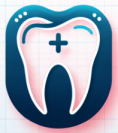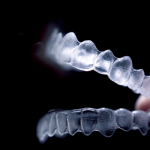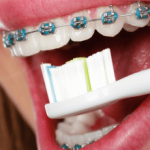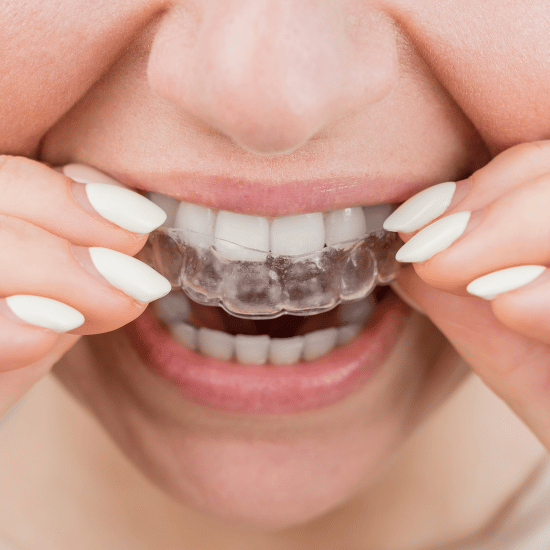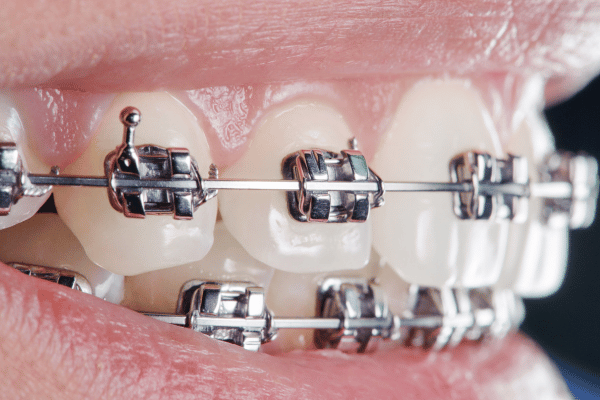Wearing clear aligners is a discreet and effective way to straighten your teeth, but it comes with its own set of challenges and keeping your breath fresh is one of them. Unlike traditional braces, clear aligners cover your teeth completely, creating a unique environment in your mouth. This setup can sometimes lead to bad breath if not managed properly. In this blog, we’ll explore how to maintain fresh breath while wearing clear aligners, ensuring you feel confident and comfortable throughout your orthodontic treatment.
Understanding Clear Aligners
Clear aligners are a modern solution for straightening teeth without the use of metal braces. They are virtually invisible, making them a popular choice among adults and teens who are looking for a less noticeable orthodontic treatment option. These aligners are custom-made to fit snugly over your teeth, gradually moving them into the desired position over time.
However, the very nature of clear aligners is being close-fitting and covering the teeth which can create challenges for oral hygiene. Since they’re worn most of the day and night, only being removed for eating, drinking anything other than water, and oral hygiene routines, they can trap food particles and bacteria against your teeth. This can lead to an increase in plaque buildup, potentially causing bad breath if the aligners and your mouth are not cleaned regularly.
“Clear aligners have revolutionized orthodontic treatment by providing an effective and discreet solution for straightening teeth. With their precise and customized approach, clear aligners offer remarkable effectiveness in achieving beautiful smiles while maintaining patient comfort and confidence.” -Dr. Athar
The Importance of Fresh Breath
Maintaining fresh breath is not just about feeling confident, it’s also important for your overall oral health. When food particles and bacteria accumulate in your mouth, they can produce odors, leading to bad breath. Moreover, these conditions can contribute to dental issues such as cavities and gum disease if not addressed. Fresh breath signifies a clean and healthy mouth, something especially crucial when you’re undergoing treatment with clear aligners.
Here are some reasons why fresh breath matters:
- Health: A clean mouth helps prevent the buildup of plaque, which can lead to gum disease and tooth decay.
- Confidence: Knowing your breath is fresh boosts your confidence, especially important when you’re in close proximity to others.
- Comfort: Maintaining good oral hygiene and fresh breath can make the experience of wearing aligners more comfortable and pleasant.
Wearing clear aligners doesn’t have to mean compromising on fresh breath. With the right practices, you can ensure your mouth stays clean and your breath stays fresh throughout your treatment. In the following sections, we’ll discuss common causes of bad breath when wearing aligners and share effective tips for keeping your breath fresh.
Common Causes of Bad Breath with Clear Aligners
Bad breath, or halitosis, can be a concern for many clear aligner users. Understanding what contributes to it can help you take effective measures to prevent it. Here are some common culprits behind bad breath when wearing clear aligners:
- Trapped Food Particles and Bacteria: One of the main reasons for bad breath with aligners is the trapping of food particles and bacteria. Clear aligners fit snugly over your teeth, which can sometimes trap food remnants and bacteria, providing a breeding ground for them to thrive, leading to unpleasant odors.
- Lack of Saliva Flow: Saliva plays a crucial role in maintaining oral health. It helps wash away food particles and bacteria, neutralizes acids produced by bacteria, and aids in digestion. Wearing clear aligners can sometimes reduce saliva flow, making it harder to keep your mouth clean and fresh.
- Inadequate Cleaning of Aligners: Not cleaning your aligners properly or regularly can lead to the buildup of bacteria and plaque, not just on your teeth but on the aligners themselves. This buildup can contribute significantly to bad breath.
- Drinking Beverages with Aligners: Drinking anything other than water with your aligners can increase the risk of bad breath. Beverages, especially sugary drinks or coffee, can seep into the aligners, feeding bacteria that cause bad breath.
Tips for Maintaining Fresh Breath
Maintaining fresh breath while wearing clear aligners involves a combination of proper oral hygiene and aligner care. Here are some tips to help you keep your breath fresh throughout your orthodontic treatment:
Brush and Floss Regularly
- Brush your teeth at least twice a day and floss daily. It’s best to brush after every meal or snack before putting your aligners back in to prevent trapping food particles and bacteria.
- Use a soft-bristled toothbrush and fluoride toothpaste to gently clean all surfaces of your teeth.
- Flossing helps remove food particles and plaque from between your teeth, areas where your toothbrush might not reach.
Clean Your Aligners Properly
- Rinse your aligners every time you take them out. Use clear aligner cleaning solutions or lukewarm water to clean them. Avoid using hot water, as it can warp the aligners.
- Brush your aligners gently with a soft-bristled toothbrush. Do not use toothpaste directly on them, as it can be abrasive and cloud the plastic.
- Consider using aligner cleaning tablets for a deeper clean. These are specially designed to remove bacteria and prevent odor without damaging the aligners.
Stay Hydrated
- Drinking plenty of water throughout the day helps maintain saliva flow, washing away food particles and bacteria that can cause bad breath.
- Water also helps prevent dry mouth, a common issue that can exacerbate bad breath.
Avoid Certain Foods and Beverages
- Certain foods, like onions, garlic, and spicy dishes, can contribute to bad breath. While it’s not always possible to avoid them completely, it’s helpful to brush and rinse after consuming them.
- Minimize the intake of sugary beverages and alcohol, as they can promote the growth of bacteria in your mouth.
Chew Sugar-Free Gum
- Chewing sugar-free gum can stimulate saliva production, helping to cleanse your mouth and freshen your breath. Look for gums with xylitol, which can help reduce the growth of bacteria in your mouth.
Regular Dental Check-ups
- Regular visits to your dentist or orthodontist are essential during your treatment with clear aligners. They can help identify and address any oral hygiene issues that could be contributing to bad breath.
By following these tips, you can effectively manage and prevent bad breath while undergoing treatment with clear aligners. Maintaining diligent oral hygiene practices and caring for your aligners are key to ensuring that your breath stays fresh, and your smile remains healthy and bright.
Products and Solutions for Fresh Breath
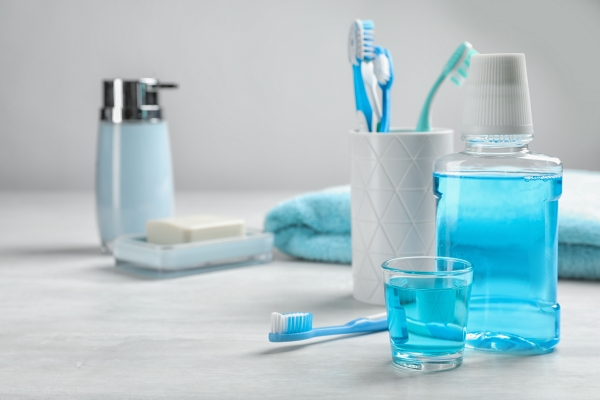
Maintaining fresh breath while wearing clear aligners goes beyond just brushing and flossing. Various products can enhance your oral hygiene routine, ensuring your mouth stays clean and your breath stays fresh throughout your treatment. Here’s a closer look at some recommended products and natural solutions:
- Specialized Cleaning Solutions for Aligners: Aligner cleaning solutions or tablets are designed to keep your aligners free from bacteria and odor. Soaking your aligners in these solutions can help remove plaque and eliminate smells, contributing to fresher breath.
- Antibacterial Mouthwash: Using an antibacterial mouthwash can help reduce the bacteria in your mouth, especially in hard-to-reach areas. Opt for alcohol-free versions to prevent dry mouth, which can worsen breath issues.
- Water Flossers: Water flossers are an excellent addition to traditional flossing, especially for individuals wearing aligners. They use a stream of water to clean between teeth and along the gum line, effectively removing trapped food particles and bacteria.
- Tongue Scrapers: A significant amount of bacteria can reside on the surface of your tongue, contributing to bad breath. Tongue scrapers are designed to remove this layer of bacteria, helping to keep your breath fresh.
- Sugar-Free Gum with Xylitol: Chewing sugar-free gum, particularly those containing xylitol, can stimulate saliva production, helping to neutralize acids and wash away bacteria. Just remember to remove your aligners before chewing gum.
- Natural Remedies: Natural remedies like rinsing with a solution of water and a few drops of peppermint oil can offer a quick freshness boost. Drinking green tea has also been shown to reduce bacteria and improve breath quality.
When to See a Professional
While maintaining diligent oral hygiene can prevent most cases of bad breath associated with clear aligners, there are times when professional intervention is necessary. Here are signs that it’s time to consult your orthodontist or dentist:
- Persistent Bad Breath: If your bad breath continues despite following a strict oral hygiene routine and using the products mentioned above, it could indicate an underlying issue such as gum disease or tooth decay.
- Gum Irritation or Bleeding: Irritation, redness, or bleeding of the gums can be signs of gingivitis or other gum diseases that contribute to bad breath. Early professional assessment and treatment can prevent more serious conditions.
- Discomfort or Pain: Aligners should be comfortable to wear. If you experience persistent discomfort or pain, it might indicate an improper fit or other issues requiring adjustment by your orthodontist.
- Visible Plaque or Tartar Buildup: If you notice plaque or tartar buildup that you can’t remove with your regular cleaning routine, it’s time for a professional cleaning. Buildup can harbor bacteria, leading to bad breath and other oral health issues.
- Cracks or Damage to Aligners: Damaged aligners can affect the treatment process and might also contribute to hygiene issues. If you notice any damage, contact your orthodontist for advice on the next steps.

Final Thoughts
Incorporating these products and solutions into your daily routine can significantly impact your oral hygiene and breath freshness while wearing aligners. It’s always a good idea to discuss any new products with your orthodontist before adding them to your oral care regimen to ensure they’re compatible with your aligners and overall treatment plan.Regular check-ups with your orthodontist are crucial for monitoring your treatment progress and ensuring your aligners fit correctly. These visits also provide an opportunity to address any concerns about breath odor or oral hygiene. Your orthodontist can offer personalized advice and solutions, ensuring your treatment experience is both effective and comfortable.
<!–
Begin your teeth transformation journey by taking a Free Assessment today.
–>
FAQs
1. How long does teeth straightening typically take for adults?
The duration varies significantly depending on the complexity of the case and the chosen treatment method. On average, it can range from 6 months to 2 years. Your orthodontist can provide a more accurate timeline based on your individual needs.
2. Can I eat with my clear aligners in?
It’s best to remove your aligners when eating. Food particles can get trapped between your aligners and teeth, leading to bacteria growth and bad breath. Always rinse your mouth and aligners before putting them back in.
3. Why is my breath worse with clear aligners?
Bad breath with clear aligners can occur due to trapped food particles, reduced saliva flow, or inadequate cleaning of the aligners. Maintaining good oral hygiene and aligner care routines can help mitigate this issue.
4. What should I do if my aligners cause gum irritation or bad breath?
If you experience gum irritation or persistent bad breath, consult your orthodontist. They can check if your aligners fit correctly and address any underlying oral health issues that may contribute to the problem.
The post Maintaining Fresh Breath While Wearing Clear Aligners appeared first on The Dentistry Blog.
